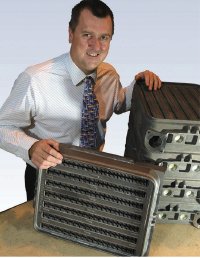Re-inventing the role of cast iron

Bob Walsh explains that new designs of cast-iron heat exchangers are smaller, lighter, use fewer sections and can achieve 50% more output than previous designs.
Cast-iron boilers have a big future says BOB WALSH. Investment in the latest technology has ensured that the cast-iron boilers available today are more than up to the job required of them.Cast iron has been the traditional boiler material for many years, but as technology has moved on, condensing boilers became the favoured option for many installations. The original cast-iron boilers were large and heavy, limited by the casting technology of the time. It invariably involved a simple green-sand process, which created thick sections. They were suited to the atmospheric burners around then, but inevitably things changed with the advent of ever more demanding energy-efficiency legislation. The bulk of gas burners now are pre-mix, using a fan to mix gas and air before reaching the burner and giving a great deal more energy output than an atmospheric burner. Cast-iron technology has kept up with the changes.
Thermal mass People looking for more compact boilers invested in stainless steel or aluminium technology, which was lighter and seemingly more efficient. But the drawbacks of these materials are that they have a low thermal mass, so that although the boiler heats up very quickly it also cools quickly — creating excessive cycling and therefore needing more-sophisticated controls. In addition, these materials can create additional demands on the installer and end user relating to the water quality in the system. Our response was to design a completely new high-performance heat exchanger, using tried-and-trusted cast iron. Whilst many manufacturers were abandoning cast iron, we invested in developing a solution using specialist foundry expertise to produce a precise high fin definition casting that achieves outstanding heat transfer. Using cast iron retains the key benefits that make it such a favourite in commercial boiler installations. Cast iron has many benefits. It is system friendly, as it does not react with materials such as copper, steel or brass. In comparison, aluminium requires special treatment in the water to prevent corrosion. Its longevity and proven reliability, without the need for special water treatment, means cast iron boilers will be much more tolerant of a low-maintenance regime.
New generation cast iron Many people picture cast iron boilers as the large sectional boilers with pressure jet burners. However, Hamworthy uses cast iron in much more compact horizontal-section modular boilers, originally introduced in the early 1960s as the R Series, to be followed in the 1980s by the UR range and then in the 1990s by the Purewell. These cast-iron heat exchangers are smaller, lighter, use fewer sections and can achieve 50% more output than previous designs. The heat exchangers are factory assembled and tested for a working pressure of 7 bar. Whilst domestic applications have the physical constraints of requiring small lightweight boilers (generally wall hung), this is invariably not the case in the commercial market. Buildings have dedicated plant rooms, so that size and weight are less critical than durability and reliability.
Cast-iron compliance Such cast-iron, high-efficiency, condensing, modular gas-fired boilers meet and exceed current and future regulations — and have the added benefits of longevity and robustness. They are suited to replacement systems — replacing like for like, but using the latest technology with the highest environmental credentials. The Purewell VariHeat range, for example, occupies the same footprint as its predecessors, but has 50% higher output, exceptional seasonal efficiency performance and exceeds the Building Regulations coming into force early next year.
Emissions and efficiency The zero/low carbon emissions challenge is a key element of the Energy Performance in Buildings Directive, which is scheduled for implementation in January 2006. As the emissions from a boiler are the effect of combustion performance, we developed a downward-firing pre-mix burner to ensure even heat distribution across the heat exchanger. The burner is fitted on top of the primary cast-iron heat exchanger, with a secondary heat exchanger positioned in the base of the boiler to maximise heat recovery from the flue gases and condensing performance. Emissions ensure European Class 5 classification for NOx, and is less than 40 mg/kWh, 23 ppm (DAF).
Bob Walsh is technical director with Hamworthy Heating, Fleets Corner, Poole, Dorset BH17 0HH.


